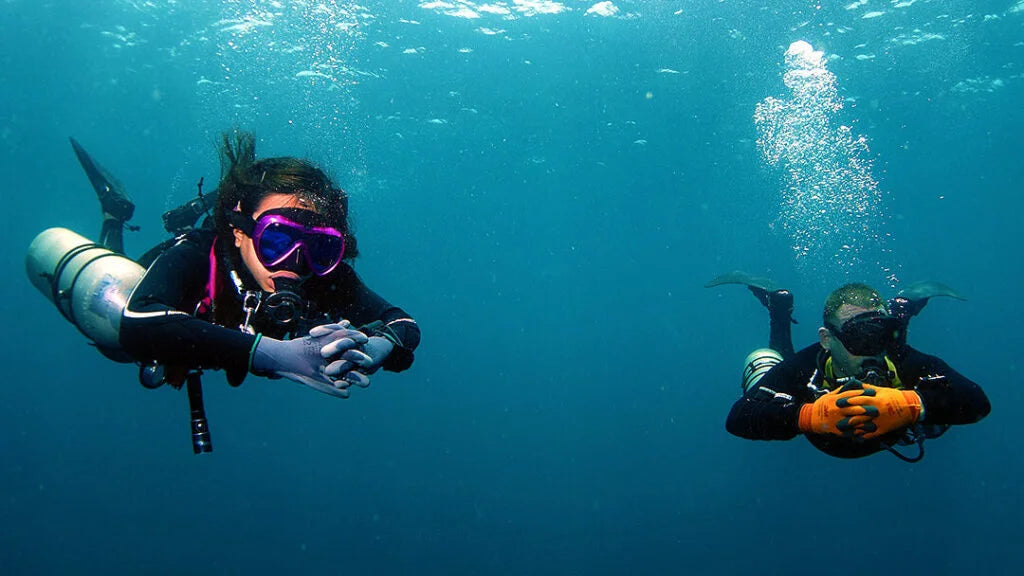Here’s a concise 6-month scuba tank maintenance schedule: Inspect visually for dents/corrosion, check hydrostatic testing every 5 years, and service the valve annually; clean interiors if used in saltwater, ensure O-rings are lubricated, and verify working pressure (typically 200-300 bar). Store upright in a cool, dry place to prevent moisture damage, and always monitor the tank’s external coating for wear. Professional inspection every 6 months is critical for safety.
Check for Damage
A scuba tank is built to last, but regular inspections are crucial—6-month checks catch 90% of issues before they become serious. Most tanks are made of aluminum or steel, with aluminum being lighter (typically 2.5–4 kg) but more prone to external corrosion, while steel tanks (weighing 3–6 kg) resist saltwater better but can rust internally if not dried properly. A single deep dent (over 3 mm) can weaken the tank’s structure, and corrosion pits deeper than 1 mm may require professional assessment.
Look for scratches deeper than 0.5 mm, especially near the neck or base where stress concentrates. Steel tanks should be checked for reddish-brown rust spots, while aluminum tanks may show white powdery oxidation. If you dive in saltwater, rinse the tank within 24 hours—salt accelerates corrosion by 30–50% faster than freshwater exposure.
For visual inspections, use a bright light at a 45-degree angle to highlight imperfections. A magnet test helps detect hidden thinning in steel tanks—if the magnet slides too easily, the metal may be compromised. Hydrostatic testing (required every 5 years) checks structural integrity, but between tests, a tap test can reveal hidden cracks—a clear "ping" means good condition, while a dull "thud" suggests internal damage.
Common damage thresholds:
- Dents: More than 3 mm deep or located near seams/valves = immediate professional check.
- Corrosion: Pits deeper than 1 mm or covering >10% of the surface = likely replacement.
- Thread wear: If the tank valve threads show visible stripping, the tank may fail pressure tests.
For emergency fixes, epoxy can temporarily seal minor scratches, but never use a damaged tank—ruptures at 200–300 bar are catastrophic. Annual professional inspections catch 95% of hidden flaws, but 6-month DIY checks save money and prevent accidents.
Quick reference:
- Safe: Minor scratches (<0.5 mm), light surface rust.
- Unsafe: Dents >3 mm, deep corrosion, valve thread damage.
- Action: If unsure, pressure-test—costs $20–50 and confirms safety.
A well-maintained tank lasts 15–20 years; neglect cuts that to 5–10 years. Spending 10 minutes every 6 months on checks avoids 80% of tank failures. If you dive weekly, inspect monthly—high use increases wear by 40%.
Test Pressure Levels
A standard aluminum 80-cubic-foot tank holds 3,000 psi (207 bar) when full, but pressure naturally drops 5-10% per month due to minor leaks and temperature changes. If a tank sits unused for 6+ months, it may lose 15-20% of its rated pressure, making a pre-dive check critical.
Most recreational tanks range from 2,400 to 3,500 psi (165-241 bar), with deviations beyond ±10% indicating potential valve or structural issues. Use a high-quality pressure gauge (accuracy within ±3%) for testing. Cheaper gauges often drift by 5-10%, risking false readings.
For tanks stored below 50°F (10°C), pressure drops roughly 1 psi per 1°F decrease. Conversely, heat exposure above 120°F (49°C) can spike pressure by 15-20%, triggering the burst disc (set to rupture at 1.5x working pressure). Never test a recently filled tank—let it stabilize for 2-3 hours to avoid false highs from thermal expansion.
Pressure loss red flags:
- >10% drop overnight = Likely valve leak (costs $20-50 to fix).
- >5% monthly loss = O-ring or thread issue (requires $10-30 in parts).
- Erratic gauge readings = Contaminated air or moisture damage.
If refilling a partially used tank, note that each 500 psi (34 bar) loss equals ~10% less air time. A tank at 2,000 psi (138 bar) gives 25-30 minutes at 30 ft (9 m), while a full 3,000 psi tank lasts 45-50 minutes. Always cross-check with your dive computer’s air integration—mismatches over 200 psi (14 bar) signal gauge problems.
Testing frequency:
- Before every dive (mandatory for safety).
- Monthly for stored tanks (even if unused).
- After any impact (drops can damage valves).
For professional verification, hydrostatic tests (required every 5 years) measure structural integrity under 5/3 working pressure for 30 seconds. Between tests, a simple tap-and-listen method helps: a hollow ring means proper pressure retention, while a dull sound suggests internal moisture or corrosion.
Quick reference:
- Normal: 2,700-3,300 psi (186-228 bar) for a 3,000 psi tank.
- Warning: <2,400 psi (165 bar) or >3,500 psi (241 bar).
- Action: If pressure fluctuates >5% between checks, service the valve.
Costs breakdown:
- Pressure gauge calibration: $15-40.
- Valve overhaul: $50-120.
- Hydrostatic test: $30-80.
Tanks maintaining >95% pressure stability between dives typically last 20+ years Those losing >10% monthly often need replacement within 5-7 years. Investing 5 minutes per check prevents 80% of pressure-related failures. For frequent divers, annual professional inspections catch hidden issues missed by DIY tests.

Clean and Lubricate
Keeping your scuba tank clean and properly lubricated isn't just about maintenance—it's about extending its lifespan by 5-10 years. Saltwater exposure causes 80% of tank corrosion cases, and improper lubrication leads to 30% of valve failures. A well-maintained tank should last 15-20 years, while neglected ones often fail within 5-7 years.
Start with a thorough rinse after every dive—salt crystals begin forming within 2 hours of exposure. Use freshwater only (no soap) at 60-80 psi (4-5.5 bar) pressure for 3-5 minutes, focusing on the valve area where 70% of salt buildup occurs. For tanks used in saltwater, a monthly deep clean with a 10:1 water-vinegar solution removes stubborn deposits that reduce O-ring lifespan by 40-50%.
Valve threads need silicone grease (never petroleum-based—it degrades rubber by 300% faster). Apply 0.5-1 gram to O-rings—too much attracts dirt, too little causes 15-20% more friction wear. For the tank neck, use 2-3 drops of food-grade lubricant every 6 months or after 50 dives, whichever comes first.
Common mistakes to avoid:
- Over-tightening valves: Adds 50-100 psi (3.5-7 bar) of unnecessary stress to threads.
- Using WD-40: Evaporates in 2-3 weeks, leaving parts dry.
- Storing wet: Tanks left with moisture develop 2x more internal rust.
For visual inspection, check O-rings for flat spots or cracks—replace if thickness decreases by >0.2 mm. Valve seats should show no pitting deeper than 0.1 mm. A cotton swab test reveals hidden grime—if the swab turns gray, the tank needs internal cleaning ($50-100 professionally).
Cost vs. Benefit:
- DIY cleaning: 200+ valve repairs.
- Professional servicing: $80-150 every 2 years removes 95% of internal corrosion risks.
Storage protocol:
- Dry completely—leave valve open for 24 hours in <50% humidity.
- Cap threads—dust plugs cost $2-5 but prevent 80% of debris damage.
- Store upright—lying down increases moisture contact by 60%.
Inspect Valves & O-Rings
Your scuba tank's valves and O-rings are its most failure-prone components, responsible for 60% of air leaks and 40% of emergency shutdowns underwater. A single degraded O-ring can waste 200-300 psi (14-21 bar) per dive, cutting bottom time by 15-20 minutes. Proper inspection every 6 months (or after 50 dives) prevents 90% of preventable failures.
Start with the O-rings—these small but critical seals lose 0.1-0.3 mm of thickness annually. Check for flat spots, cracks, or compression set (permanent flattening). A healthy O-ring should rebound when pressed—if it stays deformed, replace it immediately ($2-5 per ring). For tanks used in saltwater, O-rings degrade 50% faster due to corrosion. The main valve O-ring (typically 3-5 mm thick) fails most often, causing slow leaks of 5-10 psi per hour.
Turn the knob fully 5-10 times—it should move smoothly with <1 lb of resistance. Stiffness indicates dirt buildup or lubricant failure. Inspect the valve seat (where the O-ring seals) for pitting deeper than 0.1 mm—even minor damage can cause 200+ psi leaks. Use a cotton swab to check for black residue (sign of rubber degradation) around the valve stem.
Pressure testing reveals hidden issues:
- Leak rate >5 psi/hour = Faulty O-ring or valve seat (fix: $20-50).
- Sudden pressure drops >50 psi = Valve stem damage (repair: $80-150).
- Inconsistent airflow = Contaminants in the valve (cleaning: $30-60).
For DIY checks, apply soapy water to closed valves—bubbles form at leak rates as low as 1 psi/hour. Professional ultrasonic testing ($50-100) detects micro-cracks invisible to the eye.
Material lifespan comparison:
| Component | Aluminum Tanks | Steel Tanks | Carbon Fiber |
|---|---|---|---|
| O-rings | 2-3 years | 3-4 years | 4-5 years |
| Valve seats | 5-7 years | 7-10 years | 10+ years |
| Valve stems | 4-6 years | 6-8 years | 8-10 years |
Cost-saving tips:
- Replace O-rings proactively (100+).
- Annual professional servicing ($80) extends valve life by 3-5 years.
- Store tanks valve-open to prevent O-ring compression damage.
Critical thresholds:
- >0.5 mm O-ring wear = Replace immediately.
- >0.2 mm valve seat pitting = Requires machining ($60-120).
- >3 lbs turning resistance = Needs lubrication/cleaning.
Tanks with properly maintained valves/O-rings maintain 98% pressure integrity, while neglected ones lose 10-20% per dive. Investing 10 minutes monthly on inspections avoids $200+ emergency repairs. For divers logging 100+ dives/year, bi-annual professional checks are mandatory—they catch 75% of developing issues before failure.
Store Properly
Storing your scuba tank correctly isn't just about organization—it's about preventing $200+ in corrosion damage and extending tank life by 5-10 years. Tanks stored improperly develop 3x more internal rust, and moisture trapped inside can degrade valves 40% faster. A well-stored tank maintains 98% pressure integrity between dives, while neglected ones lose 10-20% monthly.
Residual moisture causes 80% of internal corrosion cases, forming rust at a rate of 0.1-0.3 mm per year in steel tanks and white oxidation crusts in aluminum. After diving, rinse with freshwater and dry vertically for 24 hours—lying tanks horizontally traps 50% more moisture. Use a tank stand or rack to keep them upright; leaving them leaning at angles stresses the base and can cause micro-cracks over time.
In environments above 60% humidity, rust forms 2x faster. Store tanks in a climate-controlled space (ideal: 40-60% humidity at 60-80°F/15-27°C). Avoid garages or sheds where temperatures swing more than 30°F (17°C) daily—this causes condensation buildup, accelerating corrosion by 30%. For saltwater divers, silica gel packs ($5-10) inside the tank cap absorb residual moisture, reducing rust risk by 70%.
Always keep the valve slightly open (1/4 turn) to prevent O-ring compression damage, which causes 15-20% of slow leaks. Dust caps ($2-5) protect threads from debris that can wear down seals over 50-100 dives. Never store tanks with regulators attached—the extra weight strains the valve and can misalign O-rings, leading to 5-10 psi/hour leaks.





اترك تعليقًا
تخضع جميع التعليقات للإشراف قبل نشرها.
This site is protected by hCaptcha and the hCaptcha Privacy Policy and Terms of Service apply.